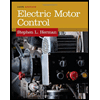
EBK ELECTRIC MOTOR CONTROL
10th Edition
ISBN: 9780100784598
Author: Herman
Publisher: YUZU
expand_more
expand_more
format_list_bulleted
Concept explainers
Question
Chapter 47, Problem 1SQ
To determine
Explain the origin of DC power for the DC motor.
Expert Solution & Answer
Explanation of Solution
DC motors are highly used in industries due to its versatility property. DC motors provide torque at a low speed. Even at the nameplate speed or above the nameplate speed, the motor can be operated constantly. DC power supply is required to operate the DC motor.
Due to the wide use of solid state rectifiers, a DC power plant and the distribution system is not required to develop the DC power. In AC distribution system, AC power can be rectified to DC power by using the solid state electronic devices at the motor site.
Conclusion:
Thus, the origin of DC power for the DC motor is explained.
Want to see more full solutions like this?
Subscribe now to access step-by-step solutions to millions of textbook problems written by subject matter experts!
Students have asked these similar questions
44. Determine Vo for the network of Fig. 8.86 if V;
with VGS(on) = 7 V and gos = 20 μS.
=
4 mV, VGS(Th)
=
4 V, and ID(on)
=
4 mA,
6. A JFET (IDSS
bias point?
=
10 mA,Vp=-5 V) is biased at ID
=
IDSS/4. What is the value of gm at that
Refer to Exhibit #15. On the kitchen pion for the northwest comer of room 132, what does the number 29, its associated electrical symbol, and the 46" AFF indicate?
Knowledge Booster
Learn more about
Need a deep-dive on the concept behind this application? Look no further. Learn more about this topic, electrical-engineering and related others by exploring similar questions and additional content below.Similar questions
- Q1/For the unity-feedback system where G (s) = K(s+ 1)(s+ 10) (s+4) (s-6) Sketch the root locus and find the value of K for which the system is closed-loop stable. Also find the break-in and breakaway points.arrow_forwardThe switch K at Figure 4 is closed at t = 0.2 second. Assuming iL(0) = 0, Find iL(t). 10 Ω w i₁(t) 2ix 20 Ω 2H 10u(t) t = 0.2 s Figure 4 Karrow_forwardThe voltage source in the circuit of Fig. P12.31 is, givenby us(t) = [10+5u(t)] V. Determine iL(t) for t ≥ 0, given thatR1 = 1 W, R2 = 1 W, L = 2 H, and C = 1 F.arrow_forward
- Don't use ai to answer I will report you answerarrow_forwardDetermine iL(t) in the circuit of Fig. P12.25, given thatbefore closing the switch uC(0−)=12 V. Also, the element valuesare R = 2 W, L = 1.5 H, and C = 0.5 F.arrow_forwardThe switch in Figure 5 is closed at t = 0 second. Find the voltage of the capacitor, vc, for t> 0. 8Ω t=0 ww + 0.15H + 24U(-t) 80- 2.5mF VC 2A 0.1H Figure 5arrow_forward
- Q1/For the unity-feedback system where G (s) = K(s+ 1)(s+ 10) (s+4) (s-6) G Sketch the root locus and find the value of K for which the system is closed-loop stable. Also find the break-in and breakaway points.arrow_forward12.22 Repeat Problem 12.21, but assume that the switch hadbeen open for a long time and then closed at t = 0. Set the dcsource at 12 mV and the element values at R0 = 5 W, R1 = 10 W,R2 = 20 W, L = 2 H, and C = 0.4 F. question 21(Determine iL(t) in the circuit of Fig. P12.21 for t ≥ 0,given that the switch was opened at t = 0 after it had been closedfor a long time, us = 12 mV, R0 = 5 W, R1 = 10 W, R2 = 20 W,L = 0.2 H, and C = 6 mF.)arrow_forwardIn Figure 1, by considering reference located at node 4, the voltage nodes will be: V1=4, V2= -5, V3=0.5 volts. If we change the location of reference to node 3, find the values for V1, V2, V4, ix, Vo, Vx and power produced by the current sources without conducting detailed node or mesh analyses. 10 www 4A ww 44 4Q 802 w + Vo 4Q 2 3 3ix Figure 1 ww 4Q 5 W4 1.50arrow_forward
- In the Figure 3 a) Find the values for Vi and ix using nodal analysis. b) Find the produced power by the current source. 50 10Ω www 37A 10Ω 20 5 ix V₁ 200 ix Figure 3 ww 100 + 4V1arrow_forward2) By series and parallel combinations find the equivalent capacitance for this circuit. ||15€ Cequivalent -66 6f 6E 12Farrow_forwardQ2/For the unity-feedback system where G(s) = K/[s (s+3) (s+ 5)], find the range of gain, K, for stability, instability, and the value of gain for marginal stability. For marginal stability also. Use the Nyquist criterion.arrow_forward
arrow_back_ios
SEE MORE QUESTIONS
arrow_forward_ios
Recommended textbooks for you

 Delmar's Standard Textbook Of ElectricityElectrical EngineeringISBN:9781337900348Author:Stephen L. HermanPublisher:Cengage Learning
Delmar's Standard Textbook Of ElectricityElectrical EngineeringISBN:9781337900348Author:Stephen L. HermanPublisher:Cengage Learning


Delmar's Standard Textbook Of Electricity
Electrical Engineering
ISBN:9781337900348
Author:Stephen L. Herman
Publisher:Cengage Learning